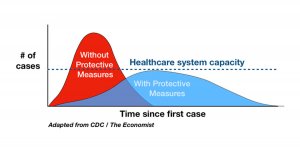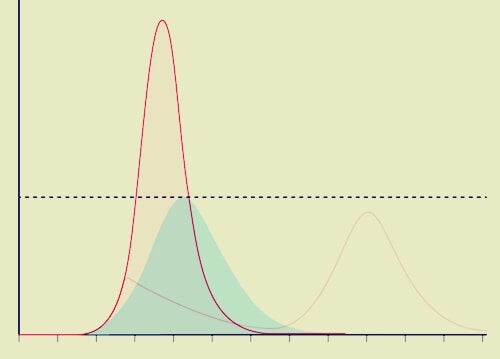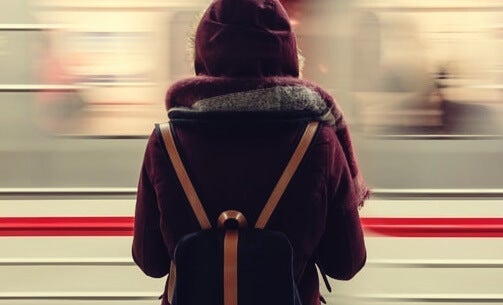Flattening the Coronavirus Curve: It's in Your Hands


Written and verified by the psychologist Valeria Sabater
Since the Director-General of the WHO, Tedros Adhanom Ghebreyesus, declared COVID-19 a pandemic on Wednesday, March 11th, little has changed. We’re still trying to contain the advance of the disease, medical institutions are trying to find a vaccine, and many countries are being urged to do something very specific and decisive: flatten the coronavirus curve.
But what’s this goal really about? In broad terms, this graph calls for citizen responsibility. It involves being mindful of our behavior and heeding safety measures in order to try to contain the virus. This isn’t just about us. It also means looking after others and, most importantly, the most vulnerable people of all: our elderly population.
The Health Ministers of several countries, as well as the representatives of the Coordination Center for Health Alerts and Emergencies, tell us that the goal is to reduce the number of those infected in order to prevent health services from collapsing under pressure. Italy is currently facing excessive saturation and is in an unprecedented state of emergency.
The goal is clear and we can achieve it: we’re all in this together, and we’re all responsible for our behavior and actions. We must follow the latest guidelines and try to flatten the coronavirus curve so that this situation becomes more manageable.

How can we flatten the coronavirus curve?
One thing is clear: there’s still no vaccine for COVID-19. There’s no way of treating the disease and, according to the WHO, the infection rate is 1.4 to 2.5. That means that each infected person can, in turn, infect between two and three people. Therefore, an important goal is to reduce that number.
In an epidemic or pandemic situation, such as the one we’re currently in, it’s vital to stop the spread. And we’re all responsible for this!
This is by no means a task exclusively for health institutions. Contagion will continue to occur, but if we mitigate the advance and lower the daily peak of infection, all of this will be much more manageable.
Thus, let’s see how we can flatten the coronavirus curve.
What exactly does that graph tell me?
What you should first observe is the horizontal dashed line on the epidemic graph. This represents a health system’s capacity to respond to the crisis. Thus, the infected curve mustn’t go beyond that line, because that’s the line that tells us that places are able to provide rapid and effective medical care for the sick.
To understand this even better, imagine the subway in rush hour. Sometimes, the carriages are so full that it’s impossible for any more passengers to enter. The subway service can’t respond to the demand, and people must stay on the platform.
The same thing can happen in health systems. If the number of infected people exceeds the hospitals’ capacities, then people can’t be given adequate care.
The goal is always to be below the saturation threshold. This way, the impact of the coronavirus will be less virulent and the situation much more manageable.

What’s the origin of this graph?
The need to flatten the coronavirus curve was based on a recent study published in the scientific journal The Lancet by Dr. Roy Anderson.
The experience of what happened in China gives us an advantage in applying similar mechanisms of containment, prevention, and action. It’s clear that this has worked because they’ve managed to contain the advance of the coronavirus. Now there are as few as 10 ten cases a day, which is extraordinary when you think of the population of China.
However, one thing is clear: China is governed by an authoritarian government. In democratic states such as Europe, for example, we may find it a little more difficult to carry out certain measures. However, there’s one thing that can, and should, be clear, and that’s our individual responsibility beyond any guidelines that the government may set.
We’re all responsible: flattening the coronavirus curve is in our hands
Flattening the curve of the coronavirus is most definitely in our hands. Beyond the typical hygiene measures, washing hands, and keeping an appropriate distance between each other, there are other scenarios as well.
Civic responsibility involves maximizing care for the most vulnerable people, those who are most at risk. We need to give special attention to elderly people with illnesses.
Many cultures are naturally close. In many places, it’s natural to embrace, greet with kisses, and shake hands. We’re social people and love to meet up with friends and family. But now is the time to take extreme measures.
We need to prevent in order to safeguard and restrict our movements and contacts in order to make this pandemic manageable and surmountable. COVID-19 has infected more than 125,000 people in just over two months and we’ve lost nearly 5000 people.
Let’s bear in mind that the slower this virus spreads, the better our health system will cope. Let’s trust our great health professionals, but above all, let’s act in a responsible, mature way in society.
These are times of uncertainty and it’s time to bring out the best in ourselves. We can do it, and it starts with you!
Since the Director-General of the WHO, Tedros Adhanom Ghebreyesus, declared COVID-19 a pandemic on Wednesday, March 11th, little has changed. We’re still trying to contain the advance of the disease, medical institutions are trying to find a vaccine, and many countries are being urged to do something very specific and decisive: flatten the coronavirus curve.
But what’s this goal really about? In broad terms, this graph calls for citizen responsibility. It involves being mindful of our behavior and heeding safety measures in order to try to contain the virus. This isn’t just about us. It also means looking after others and, most importantly, the most vulnerable people of all: our elderly population.
The Health Ministers of several countries, as well as the representatives of the Coordination Center for Health Alerts and Emergencies, tell us that the goal is to reduce the number of those infected in order to prevent health services from collapsing under pressure. Italy is currently facing excessive saturation and is in an unprecedented state of emergency.
The goal is clear and we can achieve it: we’re all in this together, and we’re all responsible for our behavior and actions. We must follow the latest guidelines and try to flatten the coronavirus curve so that this situation becomes more manageable.

How can we flatten the coronavirus curve?
One thing is clear: there’s still no vaccine for COVID-19. There’s no way of treating the disease and, according to the WHO, the infection rate is 1.4 to 2.5. That means that each infected person can, in turn, infect between two and three people. Therefore, an important goal is to reduce that number.
In an epidemic or pandemic situation, such as the one we’re currently in, it’s vital to stop the spread. And we’re all responsible for this!
This is by no means a task exclusively for health institutions. Contagion will continue to occur, but if we mitigate the advance and lower the daily peak of infection, all of this will be much more manageable.
Thus, let’s see how we can flatten the coronavirus curve.
What exactly does that graph tell me?
What you should first observe is the horizontal dashed line on the epidemic graph. This represents a health system’s capacity to respond to the crisis. Thus, the infected curve mustn’t go beyond that line, because that’s the line that tells us that places are able to provide rapid and effective medical care for the sick.
To understand this even better, imagine the subway in rush hour. Sometimes, the carriages are so full that it’s impossible for any more passengers to enter. The subway service can’t respond to the demand, and people must stay on the platform.
The same thing can happen in health systems. If the number of infected people exceeds the hospitals’ capacities, then people can’t be given adequate care.
The goal is always to be below the saturation threshold. This way, the impact of the coronavirus will be less virulent and the situation much more manageable.

What’s the origin of this graph?
The need to flatten the coronavirus curve was based on a recent study published in the scientific journal The Lancet by Dr. Roy Anderson.
The experience of what happened in China gives us an advantage in applying similar mechanisms of containment, prevention, and action. It’s clear that this has worked because they’ve managed to contain the advance of the coronavirus. Now there are as few as 10 ten cases a day, which is extraordinary when you think of the population of China.
However, one thing is clear: China is governed by an authoritarian government. In democratic states such as Europe, for example, we may find it a little more difficult to carry out certain measures. However, there’s one thing that can, and should, be clear, and that’s our individual responsibility beyond any guidelines that the government may set.
We’re all responsible: flattening the coronavirus curve is in our hands
Flattening the curve of the coronavirus is most definitely in our hands. Beyond the typical hygiene measures, washing hands, and keeping an appropriate distance between each other, there are other scenarios as well.
Civic responsibility involves maximizing care for the most vulnerable people, those who are most at risk. We need to give special attention to elderly people with illnesses.
Many cultures are naturally close. In many places, it’s natural to embrace, greet with kisses, and shake hands. We’re social people and love to meet up with friends and family. But now is the time to take extreme measures.
We need to prevent in order to safeguard and restrict our movements and contacts in order to make this pandemic manageable and surmountable. COVID-19 has infected more than 125,000 people in just over two months and we’ve lost nearly 5000 people.
Let’s bear in mind that the slower this virus spreads, the better our health system will cope. Let’s trust our great health professionals, but above all, let’s act in a responsible, mature way in society.
These are times of uncertainty and it’s time to bring out the best in ourselves. We can do it, and it starts with you!
All cited sources were thoroughly reviewed by our team to ensure their quality, reliability, currency, and validity. The bibliography of this article was considered reliable and of academic or scientific accuracy.
- Anderson, Roy How will country-based mitigation measures influence the course of the COVID-19 epidemic? The Lancet. Published March 09, 2020 DOI:https://doi.org/10.1016/S0140-6736(20)30567-5
This text is provided for informational purposes only and does not replace consultation with a professional. If in doubt, consult your specialist.







